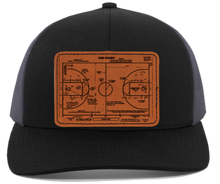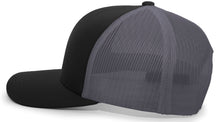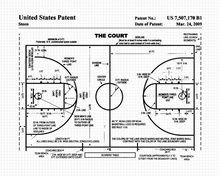Vintage B-Ball Court engraved Leather Patch hat, Industrially sewn on by hand to ensure the highest quality!
Adjustable size- 6 3/8 (51cm) to 8 (64cm)
Custom logos or designs are always available under our design your own engraved products, Design your own leather patch hats online here, Patches are engraved and sewn on, and patch options will be round, oval, and rectangular.
"Get Inspired" with JTM VINTAGE  ®
®
History facts:
Basketball has come a long way since Dr. James Naismith invented the game in the 1890s, and so have the courts that it’s played on! Though now a hardwood gym floor in a stadium-type setting is the standard, throughout the years basketball has been played on everything from cement to fields to running tracks! While the surfaces, rules, and line layouts have evolved over time, the basic basketball court layout remains the same now as it was in the 1940s.
IN THE BEGINNING…
Dr. James Naismith, a physical education teacher at Springfield College in Springfield, Massachusetts, created the sport in the 1890s when he needed an indoor activity to keep his students in shape. Since courts, greens, and other standard modern athletic surfaces weren’t around yet, he made do with peach baskets as hoops and indoor running tracks as a playing court.
Early games experimented with rules, and players made do with whatever equipment was available. Team sizes, for example, depended on the number of players present and could range from as small as 5 per team to as many as 50. Since Naismith listed no specific size for a basketball court in his original 13 rules, players adapted their game according to the gym.
Across the US, YMCA gyms hosted many of the earliest basketball games on their indoor running tracks and other such surfaces, and though the “hoop on either end” layout was the same, most other dimensions of the court (length, width, hoop height, etc.) simply adjusted to the space in which that specific game was played.
Though Naismith had originally written that basketball could be played on “any kind of ground – in a gymnasium, a large room, a small lot, a large field, whether these had uneven or smooth surfaces,” teams came to need standardized surfaces, dimensions, and layouts for the court. In 1924, rules for court sizes suggested that courts could be a maximum of 90 by 50 feet and a minimum of 60 feet by 3 feet. Early courts had no 3-point line. By the 1950s, rules such as backcourt, where players are not allowed to pass the ball back behind the halfway line once crossed, were in place, calling for new lines and markings that would help players, refs, and fans follow the game and its quickly-developing rules.







